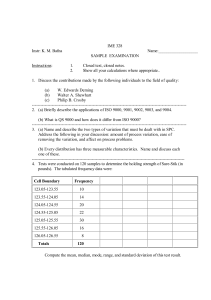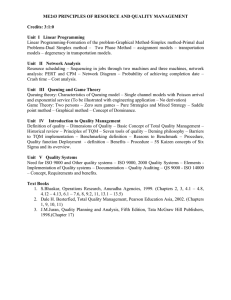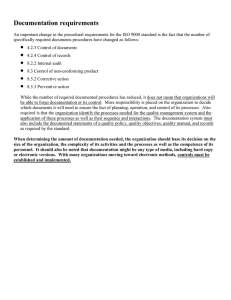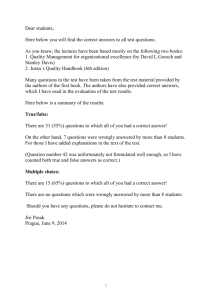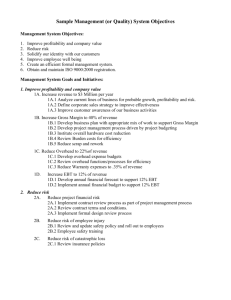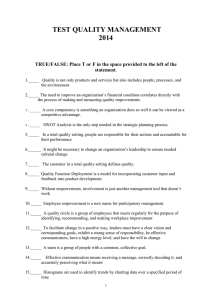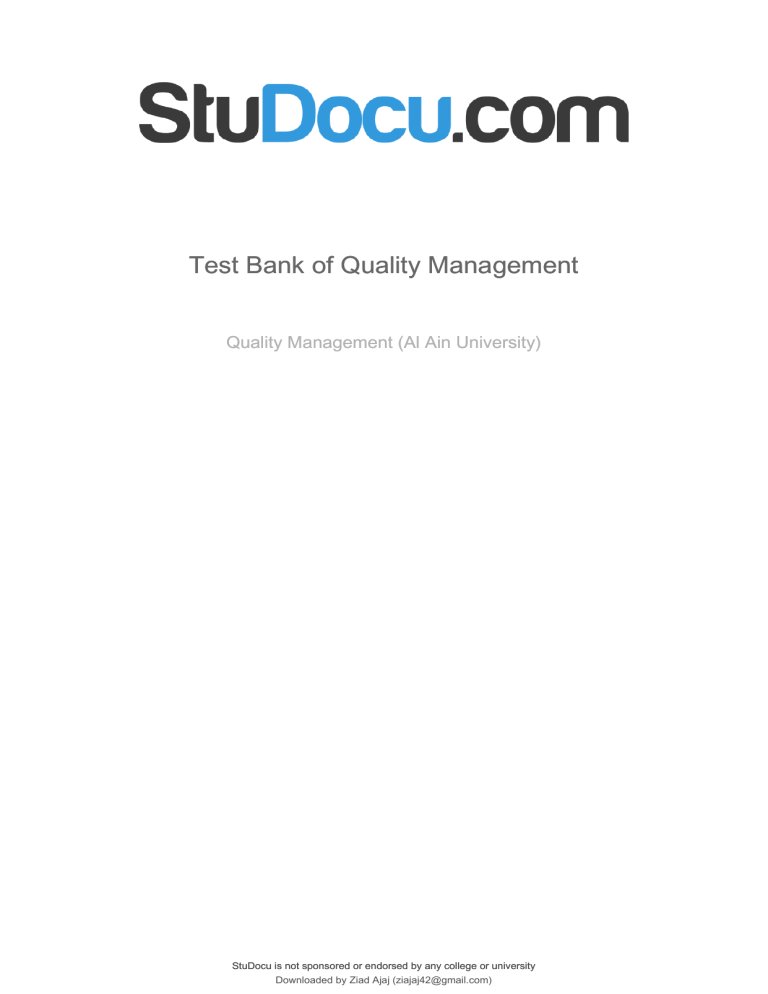
lOMoARcPSD|12626520 Test Bank of Quality Management Quality Management (Al Ain University) StuDocu is not sponsored or endorsed by any college or university Downloaded by Ziad Ajaj (ziajaj42@gmail.com) lOMoARcPSD|12626520 Chapter4 / QUALITY MANAGEMENT, ETHICS, AND CORPORATE SOCIAL RESPONSIBILITY 1. The concepts of trust, integrity, and _______ are part of the value system of total quality. A. Morality B. Responsibility C. Trust D. Legality 2. A. B. C. D. Which of the following is not a value that leads to peak performance and excellence? Creativity Quality Dependability Opportunity 3. Managers have three main responsibilities in regard to ethics. Which of the following is NOT one of those? A. They are responsible for creating an internal environment that promotes, expects, and rewards ethical behavior. B. They are responsible for helping employees make ethical choices. C. They are responsible for setting an example of ethical behavior. D. They are responsible for helping employees follow through and exhibit ethical behavior after the appropriate choices have been made. 4. When handling an ethical dilemma, managers should select the option that will most likely: A. Pass the various ethics tests B. Build strength in the organization C. Set the best example for employees D. None of the above 5. A. B. C. D. 6. When providing ethics training, it is important to: Facilitate, don’t preach Stimulate discussion Highlight practical applications All of the above are important An organization’s responsibilities for ensuring ethical behavior include: A. Paying whistleblowers to speak up B. Creating and ethical environment C. Establishing in-house courts and juries D. Refusing to talk to the media Chapter 7/ CUSTOMER SATISFACTION, RETENTION, AND LOYALTY 1. In a total quality setting, quality is defined by: A. The employee B. The customer C. The management D. The organization 2. An organization with a customer focus is: A. Outward-looking B. Inward-looking C. Established D. Continually improving 3. Downloaded can by Ziad Ajajimprove (ziajaj42@gmail.com) Which of the following mechanisms help communication? lOMoARcPSD|12626520 A. B. C. D. An internal customer Self-managed and cross-departmental teams Organization employees External customers 4. A. B. C. D. Which of the following statements are true concerning communication with customers? Must extend only to internal customers. Is never misunderstood. Is essential in a competitive marketplace Is not necessary in a small town 5. A. B. C. D. The customer loyalty model consists of which of the following components? Business performance Global perceptions Loyalty behaviors All of the above are components of the customer loyalty model 6. A. B. C. D. The best way to generate customer loyalty is to provide customers with: Rebates Discounts Superior value Uninhibited access Chapter 14/ISO 9000 AND TOTAL QUALITY: THE RELATIONSHIP 1. Appropriate motives for adopting ISO 9000 include which of the following? A. To create a quality management system B. To improve operations C. To conform to the requirements of customers D. All of the above 2. Which of the following is a documentation requirement for the ISO 9000 quality system? A. A Quality Policy B. Statement of Customer Focus C. Statement of Management Commitment D. Declaration that Teamwork is to be employed in all areas 3. A. B. C. D. 4. A. B. C. D. Which of the following statements outline the relationship factor? ISO 9000 and total quality are not in competition ISO 9000 and total quality are not interchangeable ISO 9000 is compatible with total quality All of the above Characteristics of total quality include: Scientific approach to problem solving and decision making Concerned only with quality management procedures Unity of purpose - all employees, all levels Both A & C 5. A. B. Which of the following statements is true concerning the original aims of ISO 9000? To transform organizations into competitive players in the global marketplace. To create a universally recognized family of quality standards. 6. Which of the following is a basic principle of ISO 9000? A. Certification authority held by ISO B. Continual improvement of processes and products C. Management authority D. Periodic internal audits Downloaded by Ziad Ajaj (ziajaj42@gmail.com) lOMoARcPSD|12626520 Chapter 15/ OVERVIEW OF TOTAL QUALITY TOOLS 1. The purpose of the Pareto Chart is: A. To identify and isolate the causes of a problem B. To show where to apply resources by revealing the significant few from the trivial many C. To collect variables data D. To determine the correlation between two characteristics 2. A. B. C. D. Frequency Distribution Diagram is another name for a: Pareto Chart Fishbone Diagram Scatter Diagram Histogram 3. A. B. C. D. Which chart is often referred to as a trend chart? Control Chart Run Chart Pareto Chart Scatter Diagram 4. A. B. C. D. Which of the following is used to show correlation of two variables? Run Charts Histograms Scatter Diagram Stratification 5. Which of the following reveals whether process variation is the result of a special cause? A. Control Chart B. Check Sheet C. Pareto Chart D. Run Chart Chapter 18/ OPTIMIZING AND CONTROLLING PROCESSES THROUGH STATISTICAL PROCESS CONTROL 1. A. B. C. D. The rationale for western manufacturers to embrace SPC is: Improve product quality and simultaneously reduce costs To be able to compete better with Japan and the world’s markets Improve their product image All of the above 2. A. B. C. D. The most common inhibitor of SPC is: Inadequate training Lack of resources resulting from the absence of management commitment Failure to have processes under control Low production rates 3. A. B. C. D. 4. A. B. C. D. When a process is “in control” what percent of its output will be within the ±3σ limits? 66.6% 82.4% 99.7% 100% The minimum management involvement relative to SPC training involves: Providing sufficient funding Teaching classes Commitment None of the above Downloaded by Ziad Ajaj (ziajaj42@gmail.com) lOMoARcPSD|12626520 5. A. B. C. D. The first step in the SPC execution phase is: To develop control charts Flowcharting or characterizing the process to which SPC will be applied Eliminate the special causes of variation Collect and plot SPC data Downloaded by Ziad Ajaj (ziajaj42@gmail.com)
